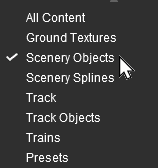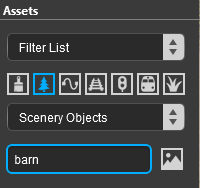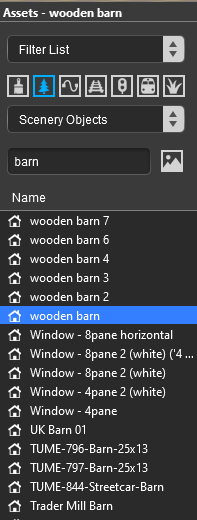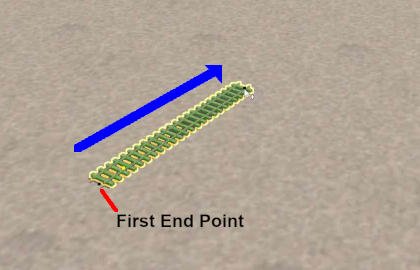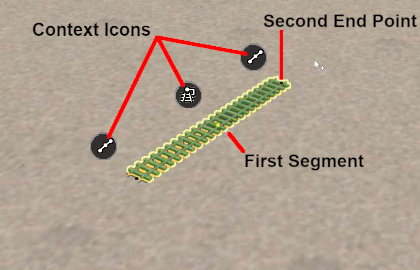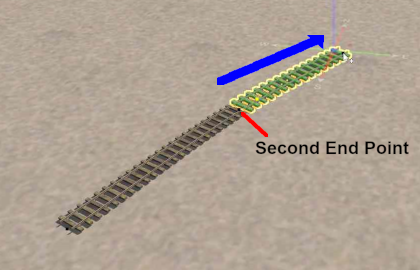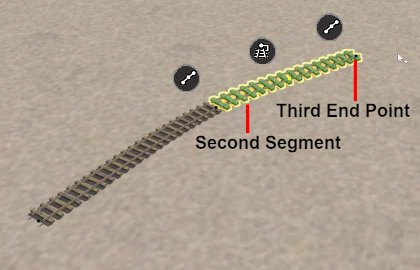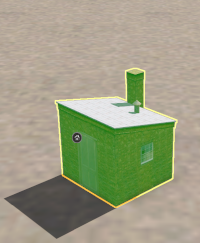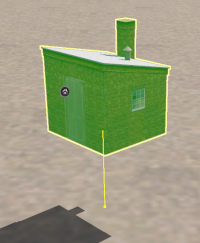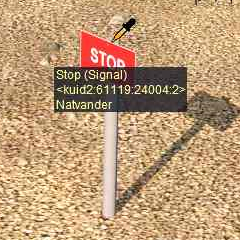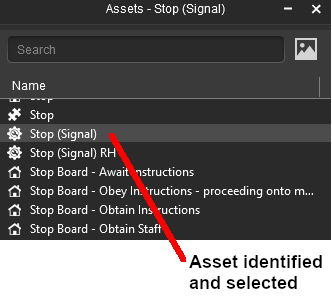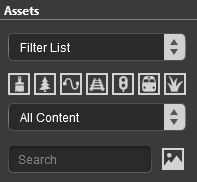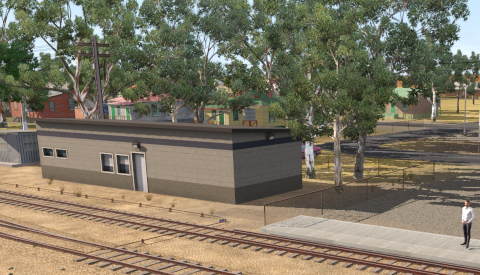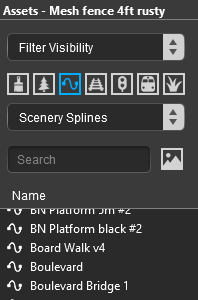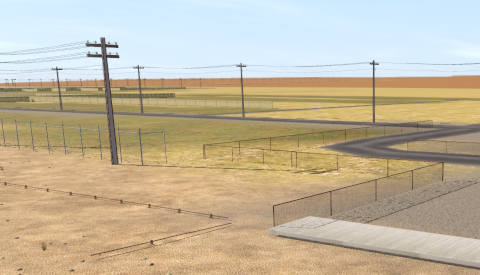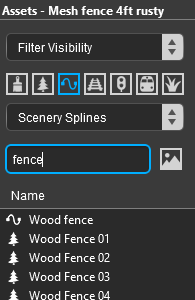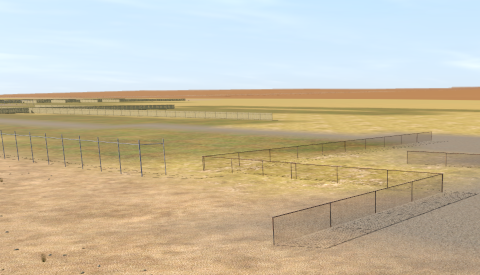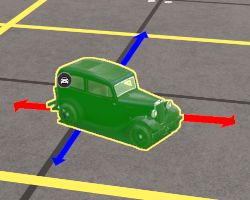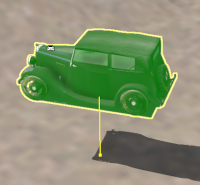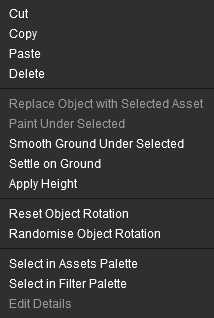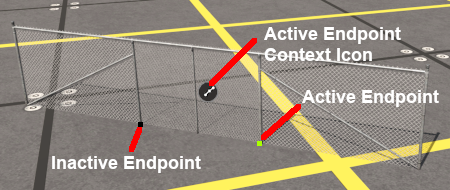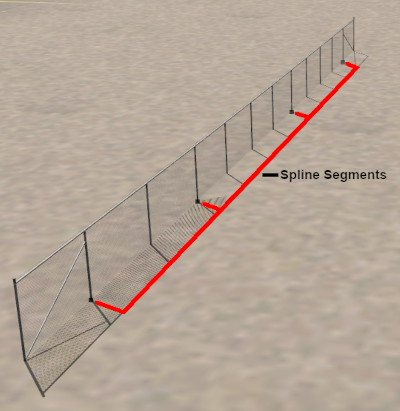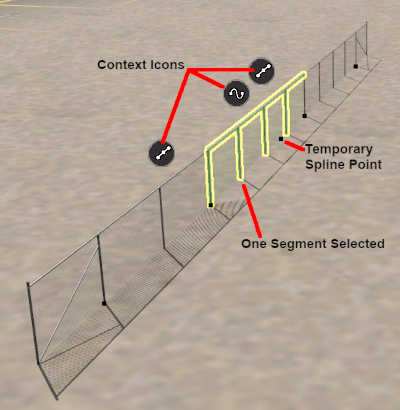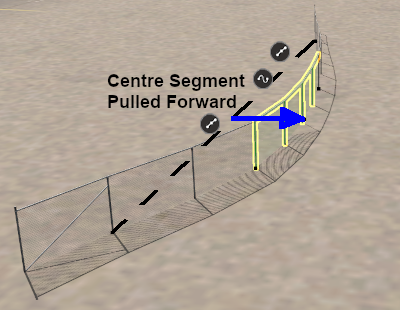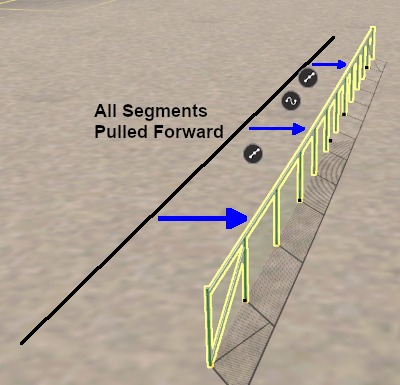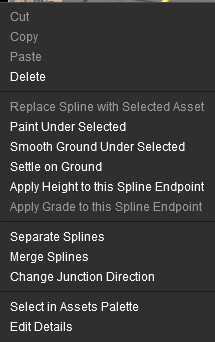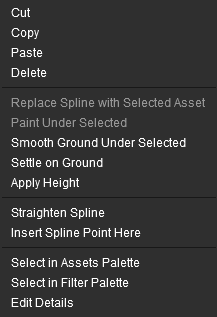How to Use S20 Tools
m |
m (→For Spline Objects (Including Track)) |
||
| Line 1,376: | Line 1,376: | ||
<tr valign="top"> | <tr valign="top"> | ||
<td>[[image:DotPoint1.JPG|link=]]</td> | <td>[[image:DotPoint1.JPG|link=]]</td> | ||
| + | <td>With the scenery object selected, enter a height value into the '''Tool Options''' <span style="font-weight: 700; font-size: 15px; color: white; background-color: black;"> Height </span> text box</td> | ||
| + | </tr> | ||
| + | <tr valign="top"> | ||
| + | <td>[[image:DotPoint2.JPG|link=]]</td> | ||
| + | <td>Hit the <span style="font-weight: 700; font-size: 15px; color: white; background-color: black;"> Enter </span> key</td> | ||
| + | </tr> | ||
| + | <tr valign="top"> | ||
| + | <td colspan=2>The scenery object will now be '''fixed''' at the entered height above (or below) the terrain as it is moved around.<br> | ||
| + | <br> | ||
| + | <table bgcolor=#000000 width=700 cellpadding=2> | ||
| + | <tr valign="top"> | ||
| + | <td> | ||
| + | <table bgcolor=#ffffe0 width=696 cellpadding=2> | ||
| + | <tr valign="top"> | ||
| + | <td>[[image:PencilTips.PNG|link=]]</td> | ||
| + | <td>The same height value can also be set using the <span style="font-size: 15px; font-weight: 700; color: white; background-color: black;"> Apply Height </span> option in the objects '''Context Menu'''.</td> | ||
| + | </tr> | ||
| + | </table> | ||
| + | </td> | ||
| + | </tr> | ||
| + | </table> | ||
| + | </td> | ||
| + | </tr> | ||
| + | </table> | ||
| + | </td> | ||
| + | </tr> | ||
| + | </table> | ||
| + | <br> | ||
| + | <span style="font-weight: 700; font-size: 17px; color: white; background-color: blue;"> Mesh Object Context Menu </span><br> | ||
| + | |||
| + | A selected scenery object, or a group of selected scenery objects, will have a '''Context Icon''' with a '''Context Menu'''. The icon design will vary between object types. Multiple objects can be selected by holding down the <span style="font-weight: 700; font-size: 15px; color: white; background-color: black;"> Shift </span> key while '''Left''' clicking on each object.<br> | ||
| + | |||
| + | To open an objects '''Context menu''' either:- | ||
| + | * '''Left''' click the '''Context Icon''', <span style="font-size: 17px; font-weight: 700;">OR</span> | ||
| + | * Press the <span style="color: white; background-color: black; font-weight: 700; font-size: 15px;"> T </span> key | ||
| + | |||
| + | <table width=900> | ||
| + | <tr valign="top"> | ||
| + | <td width=220>[[image:ContextMenuMeshObject_S20.png|link=]]</td> | ||
| + | <td width=680> | ||
| + | <table width=680 bgcolor=#000000> | ||
| + | <tr valign="top"> | ||
| + | <td> | ||
| + | <table width=676 bgcolor=#ffffff> | ||
| + | <tr valign="top"> | ||
| + | <td><span style="font-weight: 700; color: white; background-color: black;"> Cut </span></td> | ||
| + | <td>remove the selected object or objects and move them into the '''Scrapbook'''</td> | ||
| + | </tr> | ||
| + | <tr valign="top"> | ||
| + | <td><span style="font-weight: 700; color: white; background-color: black;"> Copy </span></td> | ||
| + | <td>copy the selected object or objects and place them into the '''Scrapbook'''</td> | ||
| + | </tr> | ||
| + | <tr valign="top"> | ||
| + | <td><span style="font-weight: 700; color: white; background-color: black;"> Paste </span></td> | ||
| + | <td>paste the contents of the current '''Scrapbook'''</td> | ||
| + | </tr> | ||
| + | <tr valign="top"> | ||
| + | <td><span style="font-weight: 700; color: white; background-color: black;"> Delete </span></td> | ||
| + | <td>delete the selected objects. It has the same effect as pressing the <span style="font-weight: 700; font-size: 15px; color: white; background-color: black;"> Delete </span> key</td> | ||
| + | </tr> | ||
| + | <tr valign="top"> | ||
| + | <td><span style="font-weight: 700; color: white; background-color: black;"> Smooth Ground Under Selected </span></td> | ||
| + | <td>changes the height of the terrain under the object to match the set height of the object. If multiple objects at different heights have been selected then the terrain height will be set to match the height of the lowest object</td> | ||
| + | </tr> | ||
| + | <tr valign="top"> | ||
| + | <td><span style="font-weight: 700; color: white; background-color: black;"> Settle on Ground </span></td> | ||
| + | <td>sets the height of the objects to match the height of the terrain beneath them ("drops them back to earth")</td> | ||
| + | </tr> | ||
| + | <tr valign="top"> | ||
| + | <td><span style="font-weight: 700; color: white; background-color: black;"> Apply Height </span></td> | ||
| + | <td>sets the height of the objects to the value in the '''Tool Options''' <span style="font-weight: 700; font-size: 15px; color: white; background-color: black;"> Height </span> text box</td> | ||
| + | </tr> | ||
| + | <tr valign="top"> | ||
| + | <td><span style="font-weight: 700; color: white; background-color: black;"> Reset Object Rotation </span></td> | ||
| + | <td>resets the rotation angle of the objects to their default values</td> | ||
| + | </tr> | ||
| + | <tr valign="top"> | ||
| + | <td><span style="font-weight: 700; color: white; background-color: black;"> Randomise Object Rotation </span></td> | ||
| + | <td>applies a random rotation angle to each object</td> | ||
| + | </tr> | ||
| + | <tr valign="top"> | ||
| + | <td><span style="font-weight: 700; color: white; background-color: black;"> Select in Assets Palette </span></td> | ||
| + | <td>identifies the selected object in the '''Asset Palette''' like the '''Eyedropper Tool'''</td> | ||
| + | </tr> | ||
| + | <tr valign="top"> | ||
| + | <td><span style="font-weight: 700; color: white; background-color: black;"> Edit Properties </span></td> | ||
| + | <td>opens the '''Properties''' window of the selected object</td> | ||
| + | </tr> | ||
| + | </table> | ||
| + | </td> | ||
| + | </tr> | ||
| + | </table> | ||
| + | </td> | ||
| + | </tr> | ||
| + | </table> | ||
| + | <br> | ||
| + | |||
| + | The information in this Wiki Page applies to '''Surveyor 2.0 (S20)''' as found in '''Trainz Plus'''.<br> | ||
| + | |||
| + | <span style="font-weight: 700; font-size: 17px;">This document is <span style="color: white; background-color: red;"> still being written </span></span><br> | ||
| + | <table> | ||
| + | <tr valign="top"> | ||
| + | <td> | ||
| + | __TOC__ | ||
| + | </td> | ||
| + | <td> | ||
| + | <table cellpadding=4 bgcolor=#c1e7e7> | ||
| + | <tr valign="top"> | ||
| + | <td colspan=2><span style="font-size: 17px;"><b>In Summary:</b></span></td> | ||
| + | </tr> | ||
| + | <tr valign="top"> | ||
| + | <td>[[file:DotPoint.JPG|link=]]</td> | ||
| + | <td><td> | ||
| + | </tr> | ||
| + | <tr valign="top"> | ||
| + | <td>[[file:DotPoint.JPG|link=]]</td> | ||
| + | <td><td> | ||
| + | </tr> | ||
| + | </table> | ||
| + | </td> | ||
| + | </tr> | ||
| + | </table> | ||
| + | <table> <!-- BEGIN Nav Buttons Table --> | ||
| + | <tr valign="top"> | ||
| + | <td width=729><span id="stepTools"></span> </td> | ||
| + | <td width=46>[[file:BackToTop.png|link=#top|alt=Top|Top]]</td> | ||
| + | <td width=75> </td> | ||
| + | <td width=75>[[file:NextDown.png|link=#stepPlacement|alt=Next Down|Next Down]]</td> | ||
| + | <td width=75>[[file:BackToBottom.png|link=#bottom|alt=Bottom|Bottom]]</td> | ||
| + | </tr> | ||
| + | </table> <!-- END Nav Buttons Table --> | ||
| + | |||
| + | ='''The Tools Palette'''= | ||
| + | |||
| + | <table width=1000> | ||
| + | <tr valign="top"> | ||
| + | <td>[[image:Tools_S20.png|link=|alt=Tools and keymap for S20]]</td> | ||
| + | <td> | ||
| + | <span id="Notes_Palettes"></span> | ||
| + | <table bgcolor=#000000 width=500 cellpadding=2> | ||
| + | <tr valign="top"> | ||
| + | <td> | ||
| + | <table bgcolor=#ffffb0 width=496 cellpadding=2> | ||
| + | <tr valign="top"> | ||
| + | <td width=22>[[image:NotePad.PNG|link=]]</td> | ||
| + | <td width=374><span style="font-size: 17px; font-weight: 700;">Notes: Palettes'''</span><br> | ||
| + | ---- | ||
| + | </td> | ||
| + | </tr> | ||
| + | <tr valign="top"> | ||
| + | <td colspan=2> | ||
| + | If the '''Tools Palette''' is not shown on the screen, then:- | ||
| + | <table> | ||
| + | <tr valign="top"> | ||
| + | <td width=175>[[image:WindowsMenu_S20.png|link=|alt=Windows Menu]]</td> | ||
| + | <td> | ||
| + | <table> | ||
| + | <tr valign="top"> | ||
| + | <td>1. </td> | ||
| + | <td>open the '''Window Menu''' from the menu icons at the top of the screen</td> | ||
| + | </tr> | ||
| + | <tr valign="top"> | ||
| + | <td> </td> | ||
| + | <td> | ||
| + | *visible palettes with have ticks next to their names</td> | ||
| + | </tr> | ||
| + | <tr valign="top"> | ||
| + | <td>2. </td> | ||
| + | <td>'''Left''' click on the item '''Tools Palette'''</td> | ||
| + | </tr> | ||
| + | <tr valign="top"> | ||
| + | <td> </td> | ||
| + | <td> | ||
| + | *this will add a tick and make the '''Tools Palette''' visible</td> | ||
| + | </tr> | ||
| + | <tr valign="top"> | ||
| + | <td>3. </td> | ||
| + | <td>make sure that the '''Tool Options Palette''' is also visible</td> | ||
| + | </tr> | ||
| + | </table> | ||
| + | </td> | ||
| + | </tr> | ||
| + | </table> | ||
| + | </td> | ||
| + | </tr> | ||
| + | </table> | ||
| + | </td> | ||
| + | </tr> | ||
| + | </table> | ||
| + | </td> | ||
| + | </tr> | ||
| + | </table> | ||
| + | |||
| + | ='''The Brush Tool'''= | ||
| + | |||
| + | <table width=700> | ||
| + | <tr valign="top"> | ||
| + | <td width=700> | ||
| + | <table width=500> | ||
| + | <tr valign="top"> | ||
| + | <td width=40>[[image:S20_BrushToolIcon.png|link=]]</td> | ||
| + | <td width=460>'''Keyboard Shortcut:''' <span style="color: white; background-color: black; font-weight: 700; font-size: 15px;"> W </span></td> | ||
| + | </tr> | ||
| + | </table> | ||
| + | The '''Brush Tool''' is used for '''painting''' the route. It can:- | ||
| + | *adjust the height of the terrain | ||
| + | *add ground textures | ||
| + | *add '''Effect Layers''' | ||
| + | *add '''Scrapbook''' scenes | ||
| + | When selected, the '''Brush Tool''' will show two drop down menu lists. | ||
| + | </td> | ||
| + | <td width=200>[[image:BrushTools_S20.png|link=|alt=Brush Tools]]</td> | ||
| + | </tr> | ||
| + | </table> | ||
| + | <table width=700> | ||
| + | <tr valign="top"> | ||
| + | <td colspan=3>The first drop down menu will set the '''Brush Target''', the type of brush.<br> | ||
| + | The '''Targets''' are:-</td> | ||
| + | </tr> | ||
| + | <tr valign="top"> | ||
| + | <td width=200> | ||
| + | *'''Ground Height''' | ||
| + | *'''Ground Texture''' | ||
| + | *'''Scrapbook Data''' | ||
| + | *'''<''List of Effect Layers''>''' | ||
| + | *'''Edit Effect Layers''' | ||
| + | </td> | ||
| + | <td width=150>[[image:BrushToolsGroundOptions_S20.png|link=]]</td> | ||
| + | <td width=350> | ||
| + | <table bgcolor=#000000 width=350 cellpadding=2> | ||
| + | <tr valign="top"> | ||
| + | <td> | ||
| + | <table bgcolor=#ffffb0 width=346 cellpadding=2> | ||
| + | <tr valign="top"> | ||
| + | <td>[[image:NotePad.PNG|link=]]</td> | ||
| + | <td>If you have any '''Effect Layers''' then they will appear as '''Targets''' in this drop down list. Select an '''Effect Layer''' to use the brush to paint with that effect.</td> | ||
| + | </tr> | ||
| + | </table> | ||
| + | </td> | ||
| + | </tr> | ||
| + | </table> | ||
| + | </td> | ||
| + | </tr> | ||
| + | </table> | ||
| + | <br> | ||
| + | =='''Ground Height'''== | ||
| + | |||
| + | <table width=900 bgcolor=#000000> | ||
| + | <tr valign="top"> | ||
| + | <td> | ||
| + | <table width=896 bgcolor=#ffffff> | ||
| + | <tr valign="top"> | ||
| + | <td>This brush tool uses the '''Tool Options Palette'''. If this palette is not visible on the screen then refer to [[image:PageLink.PNG|link=]] '''[[#Notes_Palettes|Notes: Palettes]]''' at the top of this document. | ||
| + | </td> | ||
| + | </tr> | ||
| + | </table> | ||
| + | </td> | ||
| + | </tr> | ||
| + | </table> | ||
| + | |||
| + | When the '''Ground Height Target''' is selected, the second drop down box will give a choice of several '''Ground Height''' tools.<br> | ||
| + | |||
| + | <table width=400> | ||
| + | <tr valign="top"> | ||
| + | <td colspan=2>The choices are:- </td> | ||
| + | </tr> | ||
| + | <tr valign="top"> | ||
| + | <td width=200> | ||
| + | *'''Height Up''' | ||
| + | *'''Height Down''' | ||
| + | *'''Set Height''' | ||
| + | *'''Grade''' | ||
| + | </td> | ||
| + | <td width=200>[[image:BrushToolsHeightOptions_S20.png|link=]]</td> | ||
| + | </tr> | ||
| + | </table> | ||
| + | |||
| + | <table width=1000> | ||
| + | <tr valign="top"> | ||
| + | <td colspan=4>The available brush tool options are shown in the '''Tool Options Palette''' with a <span style="font-size: 15px; font-weight: 700; color: gold; background-color: black;"> Gold </span> coloured icon next to their names. Those options that have their icon greyed out will be ignored, but they can still be edited.</td> | ||
| + | </tr> | ||
| + | <tr valign="top" align="center"> | ||
| + | <td width=210><span style="font-size: 15px; font-weight: 700; color: white; background-color: black;"> Height Up/Height Down </span><br>[[image:BrushToolsHeightUpDown_S20.png|link=|alt=Up/Down brush options]]</td> | ||
| + | <td width=210><span style="font-size: 15px; font-weight: 700; color: white; background-color: black;"> Set Height </span><br>[[image:BrushToolsHeightSet_S20.png|link=|alt=Height brush options]]</td> | ||
| + | <td width=210><span style="font-size: 15px; font-weight: 700; color: white; background-color: black;"> Grade </span><br>[[image:BrushToolsHeightGrade_S20.png|link=|alt=Grade brush options]]</td> | ||
| + | <td width=390><br> | ||
| + | <table bgcolor=#000000 width=390 cellpadding=2> | ||
| + | <tr valign="top"> | ||
| + | <td> | ||
| + | <table bgcolor=#ffffff width=386 align="left"> | ||
| + | <tr valign="top"> | ||
| + | <td width=90><span style="font-size: 15px; font-weight: 700; color: gold; background-color: black;"> Radius </span></td> | ||
| + | <td width=286>the brush radius (metres) - see '''Notes:''' below</td> | ||
| + | </tr> | ||
| + | <tr valign="top"> | ||
| + | <td colspan=2> | ||
| + | <table bgcolor=#ffffb0> | ||
| + | <tr valign="top"> | ||
| + | <td width=90 align="right">'''Range:''' </td> | ||
| + | <td width=296>5m and above</td> | ||
| + | </tr> | ||
| + | </table> | ||
| + | </td> | ||
| + | </tr> | ||
| + | <tr valign="top"> | ||
| + | <td><span style="font-size: 15px; font-weight: 700; color: gold; background-color: black;"> Height </span></td> | ||
| + | <td>the brush height (metres)</td> | ||
| + | </tr> | ||
| + | <tr valign="top"> | ||
| + | <td colspan=2> | ||
| + | <table bgcolor=#ffffb0> | ||
| + | <tr valign="top"> | ||
| + | <td width=90 align="right">'''Range:''' </td> | ||
| + | <td width=296>-3000m to 3000m</td> | ||
| + | </tr> | ||
| + | </table> | ||
| + | </td> | ||
| + | </tr> | ||
| + | <tr valign="top"> | ||
| + | <td><span style="font-size: 15px; font-weight: 700; color: gold; background-color: black;"> Sensitivity </span></td> | ||
| + | <td>the rate at which the height changes</td> | ||
| + | </tr> | ||
| + | <tr valign="top"> | ||
| + | <td colspan=2> | ||
| + | <table bgcolor=#ffffb0> | ||
| + | <tr valign="top"> | ||
| + | <td width=90 align="right">'''Range:''' </td> | ||
| + | <td width=296>1% (very slowly) to 100% (very fast)</td> | ||
| + | </tr> | ||
| + | </table> | ||
| + | </td> | ||
| + | </tr> | ||
| + | <tr valign="top"> | ||
| + | <td><span style="font-size: 15px; font-weight: 700; color: gold; background-color: black;"> Grade </span></td> | ||
| + | <td>slope gradient - see '''Notes:''' below</td> | ||
| + | </tr> | ||
| + | <tr valign="top"> | ||
| + | <td colspan=2> | ||
| + | <table bgcolor=#ffffb0> | ||
| + | <tr valign="top"> | ||
| + | <td width=90 align="right">'''Range:''' </td> | ||
| + | <td width=296>0% = flat ('''"Plateau"''' in '''Classic''') to</td> | ||
| + | </tr> | ||
| + | <tr valign="top"> | ||
| + | <td> </td> | ||
| + | <td>±100% = steep (but '''not''' vertical)</td> | ||
| + | </tr> | ||
| + | </table> | ||
| + | </td> | ||
| + | </tr> | ||
| + | <tr valign="top"> | ||
| + | <td><span style="font-size: 15px; font-weight: 700; color: gold; background-color: black;"> Angle </span></td> | ||
| + | <td>grade direction (compass degrees)</td> | ||
| + | </tr> | ||
| + | <tr valign="top"> | ||
| + | <td colspan=2> | ||
| + | <table bgcolor=#ffffb0> | ||
| + | <tr valign="top"> | ||
| + | <td width=90 align="right">'''Range:''' </td> | ||
| + | <td width=296>0° (North) to ±359°<br> | ||
| + | a negative value reverses the grade</td> | ||
| + | </tr> | ||
| + | </table> | ||
| + | </td> | ||
| + | </tr> | ||
| + | </table> | ||
| + | </td> | ||
| + | </tr> | ||
| + | </table> | ||
| + | </td> | ||
| + | </tr> | ||
| + | </table> | ||
| + | |||
| + | <table bgcolor=#000000 width=700 cellpadding=2> | ||
| + | <tr valign="top"> | ||
| + | <td> | ||
| + | <table bgcolor=#ffffb0 width=696 cellpadding=2> | ||
| + | <tr valign="top"> | ||
| + | <td>[[image:NotePad.PNG|link=]]</td> | ||
| + | <td><span style="font-size: 17px; font-weight: 700;">Notes:'''</span><br> | ||
| + | ---- | ||
| + | </td> | ||
| + | </tr> | ||
| + | <tr valign="top"> | ||
| + | <td width=20>[[image:DotPoint.JPG|link=]]</td> | ||
| + | <td>Unlike '''Surveyor Classic''', there appears to be no upper limit to the brush <span style="font-size: 15px; font-weight: 700; color: gold; background-color: black;"> Radius </span>. Brushes of hundreds of metres (even kilometres) in size are possible. However, if you are using the brush to set an entire baseboard, or many baseboards, to a specific height then the '''Marquee Tool''' may be a better choice.</td> | ||
| + | </tr> | ||
| + | <tr valign="top"> | ||
| + | <td width=20>[[image:DotPoint.JPG|link=]]</td> | ||
| + | <td>The <span style="font-size: 15px; font-weight: 700; color: gold; background-color: black;"> Grade </span> may cause some confusion. It is defined as '''height''' (vertical) over '''distance''' (horizontal) converted to a percentage figure. So a grade of 100% (the maximum allowed) would mean a slope formed by the height and distance both being the same value (e.g. a height increase of 50m over a distance of 50m). A vertical slope (a cliff) would have an infinite grade which is currently impossible in Surveyor.</td> | ||
| + | </tr> | ||
| + | </table> | ||
| + | </td> | ||
| + | </tr> | ||
| + | </table> | ||
| + | <br> | ||
| + | |||
| + | =='''Ground Texture'''== | ||
| + | |||
| + | <table width=900 bgcolor=#000000> | ||
| + | <tr valign="top"> | ||
| + | <td> | ||
| + | <table width=896 bgcolor=#ffffff> | ||
| + | <tr valign="top"> | ||
| + | <td>This brush tool uses the '''Tool Options Palette'''. If this palette is not visible on the screen then refer to [[image:PageLink.PNG|link=]] '''[[#Notes_Palettes|Notes: Palettes]]''' at the top of this document. | ||
| + | </td> | ||
| + | </tr> | ||
| + | </table> | ||
| + | </td> | ||
| + | </tr> | ||
| + | </table> | ||
| + | |||
| + | When the '''Ground Texture Target''' is selected, the second drop down box will be disabled - there are no brush texture tool choices.<br> | ||
| + | |||
| + | The available brush tool options are shown in the '''Tool Options Palette''' with a <span style="font-size: 15px; font-weight: 700; color: gold; background-color: black;"> Gold </span> coloured icon next to their names. Those options that have their icon greyed out will be ignored, but they can still be edited.<br> | ||
| + | |||
| + | <table width=700> | ||
| + | <tr valign="top"> | ||
| + | <td rowspan=5 width=210>[[image:BrushToolsTexture_S20.png|link=|alt=Texture brush options]]</td> | ||
| + | <td width=390> | ||
| + | <table> | ||
| + | <tr valign="top"> | ||
| + | <td width=390> | ||
| + | <table bgcolor=#000000 width=390 cellpadding=2> | ||
| + | <tr valign="top"> | ||
| + | <td> | ||
| + | <table bgcolor=#ffffff width=386> | ||
| + | <tr valign="top"> | ||
| + | <td width=90><span style="font-size: 15px; font-weight: 700; color: gold; background-color: black;"> Radius </span></td> | ||
| + | <td width=296>the brush radius (metres) - see '''Notes:''' below</td> | ||
| + | </tr> | ||
| + | <tr valign="top"> | ||
| + | <td colspan=2> | ||
| + | <table bgcolor=#ffffb0> | ||
| + | <tr valign="top"> | ||
| + | <td width=90 align="right">'''Range:''' </td> | ||
| + | <td width=296>5m and above</td> | ||
| + | </tr> | ||
| + | </table> | ||
| + | </td> | ||
| + | </tr> | ||
| + | <tr valign="top"> | ||
| + | <td><span style="font-size: 15px; font-weight: 700; color: gold; background-color: black;"> Sensitivity </span></td> | ||
| + | <td>texture transparency</td> | ||
| + | </tr> | ||
| + | <tr valign="top"> | ||
| + | <td colspan=2> | ||
| + | <table bgcolor=#ffffb0> | ||
| + | <tr valign="top"> | ||
| + | <td width=90 align="right">'''Range:''' </td> | ||
| + | <td width=296>1% = almost transparent to</td> | ||
| + | </tr> | ||
| + | <tr valign="top"> | ||
| + | <td> </td> | ||
| + | <td width=296>100% = solid (opaque)</td> | ||
| + | </tr> | ||
| + | </table> | ||
| + | </td> | ||
| + | </tr> | ||
| + | <tr valign="top"> | ||
| + | <td><span style="font-size: 15px; font-weight: 700; color: gold; background-color: black;"> Rotation </span></td> | ||
| + | <td>initial rotation angle - see '''Notes:''' below</td> | ||
| + | </tr> | ||
| + | <tr valign="top"> | ||
| + | <td colspan=2> | ||
| + | <table bgcolor=#ffffb0> | ||
| + | <tr valign="top"> | ||
| + | <td width=90 align="right">'''Range:''' </td> | ||
| + | <td width=296>0° to ±360° (larger angles can be entered)</td> | ||
| + | </tr> | ||
| + | </table> | ||
| + | </td> | ||
| + | </tr> | ||
| + | <tr valign="top"> | ||
| + | <td><span style="font-size: 15px; font-weight: 700; color: gold; background-color: black;"> Scale </span></td> | ||
| + | <td>the texture pattern scaling factor</td> | ||
| + | </tr> | ||
| + | <tr valign="top"> | ||
| + | <td colspan=2> | ||
| + | <table bgcolor=#ffffb0> | ||
| + | <tr valign="top"> | ||
| + | <td width=90 align="right">'''Range:''' </td> | ||
| + | <td width=296>0.01% = smallest to 100% = full size</td> | ||
| + | </tr> | ||
| + | </table> | ||
| + | </td> | ||
| + | </tr> | ||
| + | </table> | ||
| + | </td> | ||
| + | </tr> | ||
| + | </table> | ||
| + | </td> | ||
| + | </tr> | ||
| + | </table> | ||
| + | </td> | ||
| + | </tr> | ||
| + | </table> | ||
| + | |||
| + | <table bgcolor=#000000 width=700 cellpadding=2> | ||
| + | <tr valign="top"> | ||
| + | <td> | ||
| + | <table bgcolor=#ffffb0 width=696 cellpadding=2> | ||
| + | <tr valign="top"> | ||
| + | <td>[[image:NotePad.PNG|link=]]</td> | ||
| + | <td><span style="font-size: 17px; font-weight: 700;">Notes:'''</span><br> | ||
| + | ---- | ||
| + | </td> | ||
| + | </tr> | ||
| + | <tr valign="top"> | ||
| + | <td width=20>[[image:DotPoint.JPG|link=]]</td> | ||
| + | <td>Unlike '''Surveyor Classic''', there appears to be no upper limit to the brush <span style="font-size: 15px; font-weight: 700; color: gold; background-color: black;"> Radius </span>. Brushes of hundreds of metres (even kilometres) in size are possible. If you are using the brush to paint an entire baseboard, or many baseboards, then the '''Marquee Tool''' will be quicker but it will not give the options of changing the scale and rotation.</td> | ||
| + | </tr> | ||
| + | <tr valign="top"> | ||
| + | <td width=20>[[image:DotPoint.JPG|link=]]</td> | ||
| + | <td>The <span style="font-size: 15px; font-weight: 700; color: gold; background-color: black;"> Rotation </span> controls the starting angle for the texture when painting and is often used to avoid pattern repetition. As in '''Surveyor Classic''', holding down the <span style="font-size: 15px; font-weight: 700; color: white; background-color: black;"> [ </span> or <span style="font-size: 15px; font-weight: 700; color: white; background-color: black;"> ] </span> keys while painting will continuously change the rotation angle. | ||
| + | <table> | ||
| + | <tr valign="top"> | ||
| + | <td>[[image:Stop.PNG|link=]]</td> | ||
| + | <td>'''Warning:''' Changing the rotation angle during painting is '''not''' recommended for '''PBR Textures''' as this will significantly increase the memory useage (each rotation will load in another copy of the PBR texture).</td> | ||
| + | </tr> | ||
| + | </table> | ||
| + | </td> | ||
| + | </tr> | ||
| + | </table> | ||
| + | </td> | ||
| + | </tr> | ||
| + | </table> | ||
| + | <br> | ||
| + | |||
| + | =='''Scrapbook Data'''== | ||
| + | |||
| + | <table bgcolor=#000000 700 cellpadding=2> | ||
| + | <tr valign="top"> | ||
| + | <td> | ||
| + | <table bgcolor=#ffffe0 width=696 cellpadding=2> | ||
| + | <tr valign="top"> | ||
| + | <td>[[image:PencilTips.PNG|link=]]</td> | ||
| + | <td>The scrapbook contents can be '''Pasted''' into a route from the '''Context Menu''' of a scenery asset.</td> | ||
| + | </tr> | ||
| + | </table> | ||
| + | </td> | ||
| + | </tr> | ||
| + | </table> | ||
| + | <br> | ||
| + | <table width=900 bgcolor=#000000> | ||
| + | <tr valign="top"> | ||
| + | <td> | ||
| + | <table width=896 bgcolor=#ffffff> | ||
| + | <tr valign="top"> | ||
| + | <td>This brush tool uses both the '''Tool Options Palette''' and the '''Scrapbook Palette'''. If these palettes are not visible on the screen then refer to [[image:PageLink.PNG|link=]] '''[[#Notes_Palettes|Notes: Palettes]]''' at the top of this document.</td> | ||
| + | </tr> | ||
| + | </table> | ||
| + | </td> | ||
| + | </tr> | ||
| + | </table> | ||
| + | <br> | ||
| + | <span style="font-weight: 700; font-size: 15px; color: white; background-color: black;"> The Scrapbook Brush </span><br> | ||
| + | |||
| + | When the '''Scrapbook Data Target''' is selected, the second drop down box will give a choice of two '''Scrapbook Data''' tools.<br> | ||
| + | |||
| + | <table width=400> | ||
| + | <tr valign="top"> | ||
| + | <td colspan=2> | ||
| + | The choices are:- </td> | ||
| + | </tr> | ||
| + | <tr valign="top"> | ||
| + | <td width=200> | ||
| + | *'''Scrapbook Brush''' | ||
| + | *'''Scrapbook Clone''' | ||
| + | </td> | ||
| + | <td width=200>[[image:BrushToolsScrapbookOptions_S20.png|link=]]</td> | ||
| + | </tr> | ||
| + | </table> | ||
| + | <br> | ||
| + | <table width=900 bgcolor=#000000> | ||
| + | <tr valign="top"> | ||
| + | <td> | ||
| + | <table width=896 bgcolor=#ffffb0> | ||
| + | <tr valign="top"> | ||
| + | <td><span style="font-size: 15px; font-weight: 700; color: white; background-color: black;"> Scrapbook Brush </span> will '''resize''' the scrapbook contents to fit the selected brush shape and size. | ||
| + | *If the brush is small then the scrapbook contents will be compressed closer together | ||
| + | *If the brush is large then the contents will be spaced further apart | ||
| + | *Every '''Left Click''' will paste another complete scrapbook copy | ||
| + | *The '''Scale''' control in the '''Tool Options Palette''' is ignored.<br></td> | ||
| + | </tr> | ||
| + | <tr valign="top"> | ||
| + | <td><span style="font-size: 15px; font-weight: 700; color: white; background-color: black;"> Scrapbook Clone </span> will paste the scrapbook at its original size - subject to the '''Scale''' setting. | ||
| + | *If the brush is the same size as the original scrapbook then a single exact copy will be pasted | ||
| + | *If the brush is smaller than the original scrapbook size then only the central part of the scrapbook will be revealed and more will be added when the brush is moved around until the "painted" area reaches the size of the original. Further painting will clone or tile the scrapbook contents | ||
| + | *If the brush is larger than the original scrapbook size then the contents will be cloned or tiled to fill the set brush size | ||
| + | *The '''Scale''' control is not ignored but selecting extremes (e.g. a very large brush and a very small scale value) can cause problems (e.g. system "lockup" while it attempts to scale and clone the scrapbook contents)</td> | ||
| + | </tr> | ||
| + | </table> | ||
| + | </td> | ||
| + | </tr> | ||
| + | </table> | ||
| + | <br> | ||
| + | <table width=900> | ||
| + | <tr valign="top"> | ||
| + | <td colspan=3>The available brush tool options are shown in the '''Tool Options Palette''' with a <span style="font-size: 15px; font-weight: 700; color: gold; background-color: black;"> Gold </span> coloured icon next to their names. Those options that have their icon greyed out will be ignored, but they can still be edited.</td> | ||
| + | </tr> | ||
| + | <tr valign="top" align="center"> | ||
| + | <td width=210><span style="font-size: 15px; font-weight: 700; color: white; background-color: black;"> Scrapbook Brush </span><br>[[image:BrushToolsScrapBrush_S20.png|link=|alt=Brush options]]</td> | ||
| + | <td width=210><span style="font-size: 15px; font-weight: 700; color: white; background-color: black;"> Scrapbook Clone </span><br>[[image:BrushToolsScrapClone_S20.png|link=|alt=Clone options]]</td> | ||
| + | <td width=480><br> | ||
| + | <table bgcolor=#000000 width=480 cellpadding=2> | ||
| + | <tr valign="top"> | ||
| + | <td> | ||
| + | <table bgcolor=#ffffff width=476 align="left"> | ||
| + | <tr valign="top"> | ||
| + | <td width=90><span style="font-size: 15px; font-weight: 700; color: gold; background-color: black;"> Radius </span></td> | ||
| + | <td width=386>the brush radius (metres) - see '''Notes:''' below</td> | ||
| + | </tr> | ||
| + | <tr valign="top"> | ||
| + | <td colspan=2> | ||
| + | <table bgcolor=#ffffb0> | ||
| + | <tr valign="top"> | ||
| + | <td width=90 align="right">'''Range:''' </td> | ||
| + | <td width=386>5m and above</td> | ||
| + | </tr> | ||
| + | </table> | ||
| + | </td> | ||
| + | </tr> | ||
| + | <tr valign="top"> | ||
| + | <td><span style="font-size: 15px; font-weight: 700; color: gold; background-color: black;"> Rotation </span></td> | ||
| + | <td>initial rotation angle (degrees) - see '''Notes:''' below</td> | ||
| + | </tr> | ||
| + | <tr valign="top"> | ||
| + | <td colspan=2> | ||
| + | <table bgcolor=#ffffb0> | ||
| + | <tr valign="top"> | ||
| + | <td width=90 align="right">'''Range:''' </td> | ||
| + | <td width=386>0° to ±360° (larger angles can be entered)</td> | ||
| + | </tr> | ||
| + | </table> | ||
| + | </td> | ||
| + | </tr> | ||
| + | <tr valign="top"> | ||
| + | <td><span style="font-size: 15px; font-weight: 700; color: gold; background-color: black;"> Scale </span></td> | ||
| + | <td>the scrapbook scaling factor</td> | ||
| + | </tr> | ||
| + | <tr valign="top"> | ||
| + | <td colspan=2> | ||
| + | <table bgcolor=#ffffb0> | ||
| + | <tr valign="top"> | ||
| + | <td width=90 align="right">'''Range:''' </td> | ||
| + | <td width=386>0.01% = smallest to 100% = full size</td> | ||
| + | </tr> | ||
| + | </table> | ||
| + | </td> | ||
| + | </tr> | ||
| + | <tr valign="top"> | ||
| + | <td><span style="font-size: 15px; font-weight: 700; color: gold; background-color: black;"> Shape </span></td> | ||
| + | <td>brush shape</td> | ||
| + | </tr> | ||
| + | <tr valign="top"> | ||
| + | <td colspan=2> | ||
| + | <table bgcolor=#ffffb0> | ||
| + | <tr valign="top"> | ||
| + | <td width=90 align="right">'''Options:''' </td> | ||
| + | <td width=145>[[image:BrushToolsScrapShapes_S20.png|link=]]</td> | ||
| + | <td>'''Circle''' and '''Square''' will set the brush to the selected shape</td> | ||
| + | </tr> | ||
| + | <tr valign="top"> | ||
| + | <td> </td> | ||
| + | <td colspan=2>'''Natural''' will set the brush to the same shape as the '''Marquee''' that created the scrapbook, which may be rectangular. The '''Radius''' setting will set the ''relative'' brush dimensions</td> | ||
| + | </tr> | ||
| + | </table> | ||
| + | </td> | ||
| + | </tr> | ||
| + | </table> | ||
| + | </td> | ||
| + | </tr> | ||
| + | </table> | ||
| + | </td> | ||
| + | </tr> | ||
| + | </table> | ||
| + | |||
| + | <table bgcolor=#000000 width=700 cellpadding=2> | ||
| + | <tr valign="top"> | ||
| + | <td> | ||
| + | <table bgcolor=#ffffb0 width=696 cellpadding=2> | ||
| + | <tr valign="top"> | ||
| + | <td>[[image:NotePad.PNG|link=]]</td> | ||
| + | <td><span style="font-size: 17px; font-weight: 700;">Notes:'''</span><br> | ||
| + | ---- | ||
| + | </td> | ||
| + | </tr> | ||
| + | <tr valign="top"> | ||
| + | <td width=20>[[image:DotPoint.JPG|link=]]</td> | ||
| + | <td>Unlike '''Surveyor Classic''', there appears to be no upper limit to the brush <span style="font-size: 15px; font-weight: 700; color: gold; background-color: black;"> Radius </span>. Brushes of hundreds of metres (even kilometres) in size are possible.</td> | ||
| + | </tr> | ||
| + | <tr valign="top"> | ||
| + | <td width=20>[[image:DotPoint.JPG|link=]]</td> | ||
| + | <td>The <span style="font-size: 15px; font-weight: 700; color: gold; background-color: black;"> Rotation </span> controls the starting angle for pasting the scrapbook objects. In '''Surveyor Classic''' you could only rotate and paste in 90° increments. In '''S20''' you can rotate and paste at any angle.</td> | ||
| + | </tr> | ||
| + | </table> | ||
| + | </td> | ||
| + | </tr> | ||
| + | </table> | ||
| + | <br> | ||
| + | <table> | ||
| + | <tr valign="top"> | ||
| + | <td><span style="font-weight: 700; font-size: 15px; color: white; background-color: black;"> The Scrapbook Palette </span><br> | ||
| + | [[image:ScrapbookTools_S20.png|link=|alt=Scrapbook palette tools]]</td> | ||
| + | <td><br> | ||
| + | <table bgcolor=#000000 width=500 cellpadding=2> | ||
| + | <tr valign="top"> | ||
| + | <td> | ||
| + | <table bgcolor=#ffffff width=496 cellpadding=2> | ||
| + | <tr valign="top"> | ||
| + | <td align="center" colspan=3> | ||
| + | <span style="font-size: 15px; font-weight: 700; color: white; background-color: black;"> Scrapbook Pasting Options </span></td> | ||
| + | </tr> | ||
| + | <tr valign="top"> | ||
| + | <td bgcolor="yellow" colspan=3><span style="font-weight: 700; font-size: 15px;"> What Features to Paste </span></td> | ||
| + | </tr> | ||
| + | <tr valign="top"> | ||
| + | <td>  </td> | ||
| + | <td width=130><span style="font-size: 15px; font-weight: 700; color: white; background-color: black;"> Ground Height </span></td> | ||
| + | <td>terrain height(s) used in the scrapbook</td> | ||
| + | </tr> | ||
| + | <tr valign="top"> | ||
| + | <td>  </td> | ||
| + | <td><span style="font-size: 15px; font-weight: 700; color: white; background-color: black;"> Texture </span></td> | ||
| + | <td>textures used in the scrapbook</td> | ||
| + | </tr> | ||
| + | <tr valign="top"> | ||
| + | <td>  </td> | ||
| + | <td><span style="font-size: 15px; font-weight: 700; color: white; background-color: black;"> Meshes </span></td> | ||
| + | <td>scenery objects (e.g. trees, buildings) used in the scrapbook</td> | ||
| + | </tr> | ||
| + | <tr valign="top"> | ||
| + | <td>  </td> | ||
| + | <td><span style="font-size: 15px; font-weight: 700; color: white; background-color: black;"> Splines </span></td> | ||
| + | <td>spline objects used in the scrapbook</td> | ||
| + | </tr> | ||
| + | <tr valign="top"> | ||
| + | <td>  </td> | ||
| + | <td><span style="font-size: 15px; font-weight: 700; color: white; background-color: black;"> Effect Layers </span></td> | ||
| + | <td>effect layers ('''TurfFX''', '''Clutter''') used in the scrapbook</td> | ||
| + | </tr> | ||
| + | <tr valign="top"> | ||
| + | <td bgcolor="yellow" colspan=3><span style="font-weight: 700; font-size: 15px;"> How to Paste Each Feature</span></td> | ||
| + | </tr> | ||
| + | <tr valign="top"> | ||
| + | <td>  </td> | ||
| + | <td><span style="font-size: 15px; font-weight: 700; color: white; background-color: black;"> None </span></td> | ||
| + | <td>do not paste this feature</td> | ||
| + | </tr> | ||
| + | <tr valign="top"> | ||
| + | <td>  </td> | ||
| + | <td><span style="font-size: 15px; font-weight: 700; color: white; background-color: black;"> Add </span></td> | ||
| + | <td>add this feature to those already present</td> | ||
| + | </tr> | ||
| + | <tr valign="top"> | ||
| + | <td>  </td> | ||
| + | <td ><span style="font-size: 15px; font-weight: 700; color: white; background-color: black;"> Overwrite </span></td> | ||
| + | <td>use this feature to replace those already present</td> | ||
| + | </tr> | ||
| + | <tr valign="top"> | ||
| + | <td colspan=3>For the '''Ground Height''' feature:-</td> | ||
| + | </tr> | ||
| + | <tr valign="top"> | ||
| + | <td>  </td> | ||
| + | <td><span style="font-size: 15px; font-weight: 700; color: white; background-color: black;"> Absolute </span></td> | ||
| + | <td>use the ground heights in the scrapbook to replace the existing ground heights</td> | ||
| + | </tr> | ||
| + | <tr valign="top"> | ||
| + | <td>  </td> | ||
| + | <td><span style="font-size: 15px; font-weight: 700; color: white; background-color: black;"> Relative </span></td> | ||
| + | <td>'''modify''' the existing ground heights according to those used in the scrapbook (to '''ignore''' the scrapbook ground heights completely select the option '''None''')</td> | ||
| + | </tr> | ||
| + | </table> | ||
| + | </td> | ||
| + | </tr> | ||
| + | </table> | ||
| + | </td> | ||
| + | </tr> | ||
| + | </table> | ||
| + | <br> | ||
| + | |||
| + | =='''Edit Effect Layers...'''== | ||
| + | |||
| + | When this '''Target''' is selected, the '''Edit Effect Layers''' options will appear. This is the same as selecting '''Edit Effect Layers ...''' from the '''Trainz Edit Menu'''. | ||
| + | |||
| + | <table> | ||
| + | <tr valign="top"> | ||
| + | <td>[[image:EditMenuSelectEffectLayers.png|link=|alt=Open effect layers]]</td> | ||
| + | <td> | ||
| + | * If no Effect Layers are present then you can create a new one<br> | ||
| + | [[image:NewEffectLayerEntry.png|link=|alt=New effect layer]]</td> | ||
| + | <td> | ||
| + | * If Effect Layers are present then select one to edit<br> | ||
| + | [[image:EditEffectLayersMenu.png|link=|alt=Edit effect alyers]]</td> | ||
| + | </tr> | ||
| + | </table> | ||
| + | <br> | ||
| + | <table cellpadding=4 bgcolor="Aquamarine"> | ||
| + | <tr valign="top"> | ||
| + | <td>[[image:LinkWiki.PNG|link=]]</td> | ||
| + | <td> | ||
| + | More information on creating and editing '''Effect Layers''' can be found on the '''Trainz Wiki''' at:-<br> | ||
| + | *'''[[TurfFX_Effect_Layer]]''' | ||
| + | *'''[[Clutter_Effect_Layer]]''' | ||
| + | *'''[[Water_Effect_Layer]]''' | ||
| + | </td> | ||
| + | </tr> | ||
| + | </table> | ||
| + | <br> | ||
| + | <table> <!-- BEGIN Nav Buttons Table --> | ||
| + | <tr valign="top"> | ||
| + | <td width=729><span id="stepPlacement"></span> </td> | ||
| + | <td width=46>[[file:BackToTop.png|link=#top|alt=Top|Top]]</td> | ||
| + | <td width=75>[[file:NextUp.png|link=#stepTools|alt=Next Up|Top]]</td> | ||
| + | <td width=75>[[file:NextDown.png|link=#stepEyedropper|alt=Next Down|Next Down]]</td> | ||
| + | <td width=75>[[file:BackToBottom.png|link=#bottom|alt=Bottom|Bottom]]</td> | ||
| + | </tr> | ||
| + | </table> <!-- END Nav Buttons Table --> | ||
| + | ='''The Placement Tool'''= | ||
| + | |||
| + | <table width=700> | ||
| + | <tr valign="top"> | ||
| + | <td width=700> | ||
| + | <table width=500> | ||
| + | <tr valign="top"> | ||
| + | <td width=40>[[image:S20_PlacementToolIcon.png|link=]]</td> | ||
| + | <td width=460>'''Keyboard Shortcut:''' <span style="color: white; background-color: black; font-weight: 700; font-size: 15px;"> E </span></td> | ||
| + | </tr> | ||
| + | </table> | ||
| + | |||
| + | The '''Placement Tool''' is used to add objects to the route. | ||
| + | |||
| + | <table width=900 bgcolor=#000000> | ||
| + | <tr valign="top"> | ||
| + | <td> | ||
| + | <table width=896 bgcolor=#ffffff> | ||
| + | <tr valign="top"> | ||
| + | <td>This tool uses the '''Assets Palette'''. If this palette is not visible on the screen then refer to [[image:PageLink.PNG|link=]] '''[[#Notes_Palettes|Notes: Palettes]]''' at the top of this document. | ||
| + | </td> | ||
| + | </tr> | ||
| + | </table> | ||
| + | </td> | ||
| + | </tr> | ||
| + | </table> | ||
| + | |||
| + | The first step is to identify and select the particular object that you want to add to the route.<br> | ||
| + | <br> | ||
| + | =='''Placing a Scenery Mesh Object'''== | ||
| + | |||
| + | Individual "non-spline" scenery objects that are not attached to track are often referred to in '''Trainz''' terminology as '''Scenery Mesh Objects'''.<br> | ||
| + | <br> | ||
| + | [[image:DotPoint1.JPG|link=]] In the '''Asset Palette''' either:- | ||
| + | <table width=1000> | ||
| + | <tr valign="top"> | ||
| + | <td> | ||
| + | <table width=250 bgcolor=#0000ff> | ||
| + | <tr valign="top"> | ||
| + | <td> | ||
| + | <table width=246 bgcolor=#ffffff> | ||
| + | <tr valign="top"> | ||
| + | <td width=246 align="center">'''Left''' click on an object selection icon<br> | ||
| + | [[image:FilterSelectIcons.png|link=|alt=Filter Icons]] | ||
| + | <table> | ||
| + | <tr valign="top" align="left"> | ||
| + | <td>[[image:GroundTextureFilter_S20.png|link=]]</td> | ||
| + | <td>all ground textures</td> | ||
| + | </tr> | ||
| + | <tr valign="top" align="left"> | ||
| + | <td>[[image:SceneryMeshFilter_S20.png|link=]]</td> | ||
| + | <td>all non-spline scenery objects</td> | ||
| + | </tr> | ||
| + | <tr valign="top" align="left"> | ||
| + | <td>[[image:ScenerySplineFilter_S20.png|link=]]</td> | ||
| + | <td>all spline scenery objects</td> | ||
| + | </tr> | ||
| + | <tr valign="top" align="left"> | ||
| + | <td>[[image:TrackSplineFilter_S20.png|link=]]</td> | ||
| + | <td>all track spline objects</td> | ||
| + | </tr> | ||
| + | <tr valign="top" align="left"> | ||
| + | <td>[[image:TrackMeshFilter_S20.png|link=]]</td> | ||
| + | <td>all track objects (signals, etc)</td> | ||
| + | </tr> | ||
| + | <tr valign="top" align="left"> | ||
| + | <td>[[image:TrainFilter_S20.png|link=]]</td> | ||
| + | <td>all rolling stock</td> | ||
| + | </tr> | ||
| + | <tr valign="top" align="left"> | ||
| + | <td>[[image:PresetFilter_S20.png|link=]]</td> | ||
| + | <td>all '''Effect Layer''' presets</td> | ||
| + | </tr> | ||
| + | </table> | ||
| + | </td> | ||
| + | </tr> | ||
| + | </table> | ||
| + | </td> | ||
| + | </tr> | ||
| + | </table> | ||
| + | </td> | ||
| + | <td width=50 align="center"><span style="font-size: 17px; font-weight: 700;">OR</span></td> | ||
| + | <td> | ||
| + | <table width=250 bgcolor=#0000ff> | ||
| + | <tr valign="top"> | ||
| + | <td> | ||
| + | <table width=246 bgcolor=#ffffff> | ||
| + | <tr valign="top"> | ||
| + | <td align="center">'''Left''' click the '''Content Drop-down Box'''<br> | ||
| + | [[image:FilterSelect.png|link=|alt=Filter List]]<br> | ||
| + | Then select '''Scenery Objects'''<br> | ||
| + | [[image:FilterSelectSceneryObject_S20.png|link=|alt=Scenery Objects]] | ||
| + | </td> | ||
| + | </tr> | ||
| + | </table> | ||
| + | </td> | ||
| + | </tr> | ||
| + | </table> | ||
| + | </td> | ||
| + | <td> | ||
| + | <table bgcolor=#000000 width=400 cellpadding=2> | ||
| + | <tr valign="top"> | ||
| + | <td> | ||
| + | <table bgcolor=#ffffe0 width=396 cellpadding=2> | ||
| + | <tr valign="top"> | ||
| + | <td>[[image:PencilTips.PNG|link=]] <span style="font-size: 15px; font-weight: 700; color: white; background-color: blue;"> Shortcut </span><br> | ||
| + | If you already have the same object placed in your route then:- | ||
| + | # select the '''Eyedropper Tool''' in the '''Tools Palette''' (or press the <span style="font-weight: 700; font-size: 17px; color: white; background-color: black;"> R </span> key) | ||
| + | # '''Left''' click on the existing object object | ||
| + | This will instantly select that particular object in the filter list.<br> | ||
| + | |||
| + | Jump to '''Step [[image:DotPoint5.JPG|link=]]''' below.</td> | ||
| + | </tr> | ||
| + | </table> | ||
| + | </td> | ||
| + | </tr> | ||
| + | </table> | ||
| + | </td> | ||
| + | </tr> | ||
| + | </table> | ||
| + | <br> | ||
| + | <table width=900> | ||
| + | <tr valign="top"> | ||
| + | <td width=20>[[image:DotPoint2.JPG|link=]]</td> | ||
| + | <td>To narrow down the filter list type part of the object name into the '''Search Text Box'''. For example if you have selected '''Scenery Objects''' and want to find "barns", then type "barn" ('''UPPER/lower''' case does not matter).</td> | ||
| + | </tr> | ||
| + | </table> | ||
| + | <br> | ||
| + | <table width=900> | ||
| + | <tr valign="top"> | ||
| + | <td width=200>[[image:FilterSelectSearchBarn_S20.png|link=|alt=Text search]]</td> | ||
| + | <td><br>[[image:DotPoint3.JPG|link=]] This will list all the '''Scenery Objects''' containing the text "barn" in the filter list.<br> | ||
| + | <table width=700> | ||
| + | <tr valign="top"> | ||
| + | <td width=200>[[image:FilterSelectWoodenBarn_S20.png|link=|alt=Filtered list]]</td> | ||
| + | <td valign="middle">[[image:DotPoint4.JPG|link=]] Select ('''left''' click) on the required item in the list (e.g. "Wooden Barn").<br><br> | ||
| + | When selected the object will be highlighted on a blue background and its name will appear in the '''Assets Palette''' title bar.<br><br> | ||
| + | If you are not sure about an object then '''Dbl-Left''' click on the name to bring up its image and description.<br><br> | ||
| + | <table width=700 bgcolor=#000000> | ||
| + | <tr valign="top"> | ||
| + | <td> | ||
| + | <table width=696 bgcolor=#ffffff> | ||
| + | <tr valign="top"> | ||
| + | <td>Selecting an object in the '''Assets Palette''' filter list will automatically select the '''Placement Tool''' so the next '''Left''' click in the route will place that object in the route.</td> | ||
| + | </tr> | ||
| + | </table> | ||
| + | </td> | ||
| + | </tr> | ||
| + | </table> | ||
| + | </td> | ||
| + | </tr> | ||
| + | </table> | ||
| + | </td> | ||
| + | </tr> | ||
| + | </table> | ||
| + | <br> | ||
| + | <table width=1000> | ||
| + | <tr valign="top"> | ||
| + | <td width=500> | ||
| + | <table> | ||
| + | <tr valign="top"> | ||
| + | <td>[[image:DotPoint5.JPG|link=]] The final step is to place the selected object into the route.</td> | ||
| + | </tr> | ||
| + | <tr valign="top"> | ||
| + | <td> | ||
| + | # If the '''Placement Tool''' is not selected then '''Left''' click it or press the <span style="color: white; background-color: black; font-weight: 700; font-size: 15px;"> E </span> key | ||
| + | # '''Click''' on the spot where you want to place the object</td> | ||
| + | </tr> | ||
| + | </table> | ||
| + | </td> | ||
| + | <td width=500> | ||
| + | <table bgcolor=#000000 width=500 cellpadding=2> | ||
| + | <tr valign="top"> | ||
| + | <td> | ||
| + | <table bgcolor=#ffffb0 width=496 cellpadding=2> | ||
| + | <tr valign="top"> | ||
| + | <td>[[image:NotePad.PNG|link=]]</td> | ||
| + | <td>The '''Placement Tool''' will remain on and active until another tool has been selected. So everytime you click another copy of the object (or another object if you change your selection) will be added to the route.</td> | ||
| + | </tr> | ||
| + | </table> | ||
| + | </td> | ||
| + | </tr> | ||
| + | </table> | ||
| + | </td> | ||
| + | </tr> | ||
| + | </table> | ||
| + | <br> | ||
| + | |||
| + | =='''Placing a Scenery or Track Spline'''== | ||
| + | |||
| + | To start the process of laying a track or spline, follow the steps listed above for placing a '''Scenery Mesh Object'''.<br> | ||
| + | |||
| + | <table width=900> | ||
| + | <tr valign="top"> | ||
| + | <td rowspan=2 width=420>[[image:PlacementTrack1_S20.png|link=]]</td> | ||
| + | <td width=20>[[image:DotPoint1.JPG|link=]]</td> | ||
| + | <td>'''"Click on the spot"''' as shown in '''Step''' [[image:DotPoint5.JPG|link=]] above to place the start or first '''endpoint''' of the spline.</td> | ||
| + | </tr> | ||
| + | <tr valign="top"> | ||
| + | <td width=20>[[image:DotPoint2.JPG|link=]]</td> | ||
| + | <td>Move the mouse in the direction you want to lay the spline or track. The spline will follow the mouse wherever you move it.</td> | ||
| + | </tr> | ||
| + | <tr valign="top"> | ||
| + | <td>[[image:PlacementTrack2_S20.png|link=]]</td> | ||
| + | <td width=20>[[image:DotPoint3.JPG|link=]]</td> | ||
| + | <td>When you have the pointer in the final position for the first spline segment, '''Left''' click the mouse. This will anchor the second spline endpoint. The spline between the two endpoints is the first spline segment.<br> | ||
| + | <br> | ||
| + | The spline segment will now have three '''Context Icons''', one for each '''endpoint''' and one for the spline segment.</td> | ||
| + | </tr> | ||
| + | <tr valign="top"> | ||
| + | <td>[[image:PlacementTrack3_S20.png|link=]]</td> | ||
| + | <td width=20>[[image:DotPoint4.JPG|link=]]</td> | ||
| + | <td>'''Left''' click on the new endpoint and move the mouse in the direction you want to continue laying the spline or track. The spline will follow the mouse wherever you move it.</td> | ||
| + | </tr> | ||
| + | <tr valign="top"> | ||
| + | <td rowspan=2>[[image:PlacementTrack4_S20.png|link=]]</td> | ||
| + | <td width=20>[[image:DotPoint5.JPG|link=]]</td> | ||
| + | <td>When you have the pointer in the final position for the second spline segment, '''Left''' click the mouse. This will anchor the third spline endpoint and produce new '''Context Icons''' for the second segment.</td> | ||
| + | </tr> | ||
| + | <tr valign="top"> | ||
| + | <td width=20>[[image:DotPoint6.JPG|link=]]</td> | ||
| + | <td>Repeat '''Steps''' [[image:DotPoint4.JPG|link=]] and [[image:DotPoint5.JPG|link=]] above to continue laying the spline.</td> | ||
| + | </tr> | ||
| + | </table> | ||
| + | <br> | ||
| + | |||
| + | =='''Placement Tool Options'''== | ||
| + | <br> | ||
| + | <span style="font-weight: 700; font-size: 17px; color: white; background-color: blue;"> Mesh Object Tool Options </span><br> | ||
| + | <br> | ||
| + | The '''Placement Tool''' settings for '''Scenery Mesh Objects''' in the '''Tool Options Palette''' do not show gold coloured icons to reveal which ones are active but the <span style="font-weight: 700; font-size: 15px; color: white; background-color: black;"> Height </span> setting is active.<br> | ||
| + | |||
| + | <table width=1000> | ||
| + | <tr valign="top"> | ||
| + | <td width=200>[[image:PlacementMeshHeight0_S20.png|link=]]</td> | ||
| + | <td width=200>[[image:PlacementMeshHeight3_S20.png|link=]]</td> | ||
| + | <td> | ||
| + | <table width=600> | ||
| + | <tr valign="top"> | ||
| + | <td width=20>[[image:DotPoint1.JPG|link=]]</td> | ||
| + | <td width=580>After placing the mesh object in the route, enter a value in the '''Tool Options Palette''' <span style="font-weight: 700; font-size: 15px; color: white; background-color: black;"> Height </span> setting</td> | ||
| + | </tr> | ||
| + | <tr valign="top"> | ||
| + | <td>[[image:DotPoint2.JPG|link=]]</td> | ||
| + | <td>Press the <span style="font-weight: 700; font-size: 15px; color: white; background-color: black;"> Enter </span> key</td> | ||
| + | </tr> | ||
| + | <tr valign="top"> | ||
| + | <td colspan=2><br>The object will be moved to the set height above (or below) the terrain. The vertical yellow line shown in the second image on the left indicates the height change. The small yellow dot at the base of the line is the terrain '''anchor point''' for the object.<br> | ||
| + | <br> | ||
| + | <table bgcolor=#000000 width=600 cellpadding=2> | ||
| + | <tr valign="top"> | ||
| + | <td> | ||
| + | <table bgcolor=#ffffe0 width=596 cellpadding=2> | ||
| + | <tr valign="top"> | ||
| + | <td>[[image:PencilTips.PNG|link=]]</td> | ||
| + | <td>The height in the '''Tool Options Palette''' can also be applied using the <span style="font-size: 15px; font-weight: 700; color: white; background-color: black;"> Set Height </span> option in the objects '''Context Menu'''.</td> | ||
| + | </tr> | ||
| + | </table> | ||
| + | </td> | ||
| + | </tr> | ||
| + | </table> | ||
| + | </td> | ||
| + | </tr> | ||
| + | </table> | ||
| + | </td> | ||
| + | </tr> | ||
| + | </table> | ||
| + | <br> | ||
| + | <span style="font-weight: 700; font-size: 17px; color: white; background-color: blue;"> Spline Tool Options </span><br> | ||
| + | <br> | ||
| + | Splines have two '''Placement Tool''' settings in the '''Tool Options Palette'''. | ||
| + | |||
| + | <table width=900> | ||
| + | <tr valign="top"> | ||
| + | <td width=200>[[image:PlacementSplineTools_S20.png|link=]]</td> | ||
| + | <td> | ||
| + | <table bgcolor=#000000 width=700 cellpadding=2> | ||
| + | <tr valign="top"> | ||
| + | <td> | ||
| + | <table bgcolor=#ffffff width=696 cellpadding=2> | ||
| + | <tr valign="top"> | ||
| + | <td width=90><span style="font-size: 15px; font-weight: 700; color: gold; background-color: black;"> Grade </span></td> | ||
| + | <td>spline gradient (see '''Notes:''' below). The finishing '''endpoint''' of each spline segment will be set higher (for a '''positive''' grade) or lower (for a '''negative''' grade) than the starting '''endpoint'''</td> | ||
| + | </tr> | ||
| + | <tr valign="top"> | ||
| + | <td colspan=2> | ||
| + | <table bgcolor=#ffffb0> | ||
| + | <tr valign="top"> | ||
| + | <td width=90 align="right">'''Range:''' </td> | ||
| + | <td width=696>0% (flat) to ±100% (steep but '''not''' vertical)</td> | ||
| + | </tr> | ||
| + | </table> | ||
| + | </td> | ||
| + | </tr> | ||
| + | <tr valign="top"> | ||
| + | <td width=90><span style="font-size: 15px; font-weight: 700; color: gold; background-color: black;"> Condition </span></td> | ||
| + | <td>this applies to '''Track Spline''' objects and sets the track '''condition''' (or "ride comfort") for each segment</td> | ||
| + | </tr> | ||
| + | <tr valign="top"> | ||
| + | <td colspan=2> | ||
| + | <table bgcolor=#ffffb0> | ||
| + | <tr valign="top"> | ||
| + | <td width=90 align="right">'''Range:''' </td> | ||
| + | <td width=696>1% (terrible track condition) to 100% (perfect track condition)<br> | ||
| + | </td> | ||
| + | </tr> | ||
| + | </table> | ||
| + | <table bgcolor=#ffffe0 width=692 cellpadding=2> | ||
| + | <tr valign="top"> | ||
| + | <td>[[image:PencilTips.PNG|link=]]</td> | ||
| + | <td>The '''Track Condition''' can also be set for each track segment in its '''Context Menu''' <span style="font-size: 15px; font-weight: 700; color: white; background-color: black;"> Edit Properties </span> option</td> | ||
| + | </tr> | ||
| + | </table> | ||
| + | </td> | ||
| + | </tr> | ||
| + | </table> | ||
| + | </td> | ||
| + | </tr> | ||
| + | </table> | ||
| + | <br> | ||
| + | <table bgcolor=#000000 width=700 cellpadding=2> | ||
| + | <tr valign="top"> | ||
| + | <td> | ||
| + | <table bgcolor=#ffffb0 width=696 cellpadding=2> | ||
| + | <tr valign="top"> | ||
| + | <td>[[image:NotePad.PNG|link=]]</td> | ||
| + | <td><span style="font-size: 17px; font-weight: 700;">Notes:'''</span><br> | ||
| + | ---- | ||
| + | </td> | ||
| + | </tr> | ||
| + | <tr valign="top"> | ||
| + | <td> </td> | ||
| + | <td>The <span style="font-size: 15px; font-weight: 700; color: gold; background-color: black;"> Grade </span> may cause some confusion. It is defined as '''vertical rise''' divided by '''horizontal distance''' converted to a percentage figure. So a grade of 100% (the maximum allowed) would mean a gradient formed by both measurements having the same value (e.g. a rise of 50m over a distance of 50m). A vertical grade (such as up a cliff face) would have an infinite grade which is currently impossible in Surveyor.</td> | ||
| + | </tr> | ||
| + | </table> | ||
| + | </td> | ||
| + | </tr> | ||
| + | </table> | ||
| + | </td> | ||
| + | </tr> | ||
| + | </table> | ||
| + | <br> | ||
| + | |||
| + | =='''Deleting Placed Objects'''== | ||
| + | <br> | ||
| + | To delete objects either:- | ||
| + | <table width=900> | ||
| + | <tr valign="top"> | ||
| + | <td> | ||
| + | <table width=420 bgcolor=#0000ff> | ||
| + | <tr valign="top"> | ||
| + | <td> | ||
| + | <table width=416 bgcolor=#ffffff> | ||
| + | <tr valign="top"> | ||
| + | <td> | ||
| + | [[image:DotPoint1.JPG|link=]] Select the object or a group of objects using either the:- | ||
| + | :* '''Free Move Tool''' (or press <span style="font-weight: 700; font-size: 17px; color: white; background-color: black;"> S </span>) <span style="font-size: 17px; font-weight: 700;">OR</span> | ||
| + | :* '''Fine Adjustment Tool''' (or press <span style="font-weight: 700; font-size: 17px; color: white; background-color: black;"> D </span>) | ||
| + | ::Multiple object can be selected by holding down the <span style="font-weight: 700; font-size: 17px; color: white; background-color: black;"> Shift </span> key when using these tools | ||
| + | [[image:DotPoint2.JPG|link=]] Either:- | ||
| + | :* Press the <span style="font-weight: 700; font-size: 17px; color: white; background-color: black;"> Delete </span> key, <span style="font-size: 17px; font-weight: 700;">OR</span> | ||
| + | :* Open the '''Context Menu''' of the object (or object group) and select the <span style="font-weight: 700; font-size: 17px; color: white; background-color: black;"> Delete </span> option</td> | ||
| + | </tr> | ||
| + | </table> | ||
| + | </td> | ||
| + | </tr> | ||
| + | </table> | ||
| + | </td> | ||
| + | <td width=50 align="center"><span style="font-size: 17px; font-weight: 700;">OR</span></td> | ||
| + | <td> | ||
| + | <table width=420 bgcolor=#0000ff> | ||
| + | <tr valign="top"> | ||
| + | <td> | ||
| + | <table width=416 bgcolor=#ffffff> | ||
| + | <tr valign="top"> | ||
| + | <td> | ||
| + | <table> | ||
| + | <tr valign="top"> | ||
| + | <td width=20>[[image:DotPoint1.JPG|link=]]</td> | ||
| + | <td>Use the '''Marquee Tool''' to select the object or a group of objects, then either:- | ||
| + | * Press the <span style="font-weight: 700; font-size: 17px; color: white; background-color: black;"> Delete </span> key <span style="font-size: 17px; font-weight: 700;">OR</span> | ||
| + | * Open the '''Marquee''' '''Context Menu''' and select the <span style="font-weight: 700; font-size: 17px; color: white; background-color: black;"> Delete </span> option</td> | ||
| + | </tr> | ||
| + | </table> | ||
| + | </td> | ||
| + | </tr> | ||
| + | </table> | ||
| + | </td> | ||
| + | </tr> | ||
| + | </table> | ||
| + | </td> | ||
| + | </tr> | ||
| + | </table> | ||
| + | |||
| + | <br> | ||
| + | <table> <!-- BEGIN Nav Buttons Table --> | ||
| + | <tr valign="top"> | ||
| + | <td width=729><span id="stepEyedropper"></span> </td> | ||
| + | <td width=46>[[file:BackToTop.png|link=#top|alt=Top|Top]]</td> | ||
| + | <td width=75>[[file:NextUp.png|link=#stepPlacement|alt=Next Up|Top]]</td> | ||
| + | <td width=75>[[file:NextDown.png|link=#stepFreeMove|alt=Next Down|Next Down]]</td> | ||
| + | <td width=75>[[file:BackToBottom.png|link=#bottom|alt=Bottom|Bottom]]</td> | ||
| + | </tr> | ||
| + | </table> <!-- END Nav Buttons Table --> | ||
| + | <br> | ||
| + | ='''The Eyedropper Tool'''= | ||
| + | |||
| + | <table width=700> | ||
| + | <tr valign="top"> | ||
| + | <td width=700> | ||
| + | <table width=500> | ||
| + | <tr valign="top"> | ||
| + | <td width=40>[[image:S20_DropperToolIcon.png|link=]]</td> | ||
| + | <td width=460>'''Keyboard Shortcut:''' <span style="color: white; background-color: black; font-weight: 700; font-size: 15px;"> R </span></td> | ||
| + | </tr> | ||
| + | </table> | ||
| + | <br> | ||
| + | The '''Eyedropper Tool''' is used to identify objects that are in the route. The objects can be textures, effect layers, scenery, rolling stock, track. track equipment, and splines.<br> | ||
| + | |||
| + | <table width=900 bgcolor=#000000> | ||
| + | <tr valign="top"> | ||
| + | <td> | ||
| + | <table width=896 bgcolor=#ffffff> | ||
| + | <tr valign="top"> | ||
| + | <td>This tool uses the '''Assets Palette'''. If this palette is not visible on the screen then refer to [[image:PageLink.PNG|link=]] '''[[#Notes_Palettes|Notes: Palettes]]''' at the top of this document. | ||
| + | </td> | ||
| + | </tr> | ||
| + | </table> | ||
| + | </td> | ||
| + | </tr> | ||
| + | </table> | ||
| + | <br> | ||
| + | =='''Quick Steps'''== | ||
| + | |||
| + | [[image:DotPoint1.JPG|link=]] With the '''Eyedropper Tool''' selected, move the mouse pointer (which will now be an eyedropper symbol) onto any object in view.<br> | ||
| + | |||
| + | <table width=1000> | ||
| + | <tr valign="top"> | ||
| + | <td>[[image:EyedropperToolSelect1_S20.png|link=|alt=Eyedropper]]<br><br> | ||
| + | [[image:EyedropperToolSelect2_S20.png|link=|alt=Eyedropper]]</td> | ||
| + | <td rowspan=2> | ||
| + | <table bgcolor=#000000 width=760 cellpadding=2> | ||
| + | <tr valign="top"> | ||
| + | <td> | ||
| + | <table bgcolor=#ffffb0 width=756 cellpadding=2> | ||
| + | <tr valign="top"> | ||
| + | <td> | ||
| + | The object will be identified by its object name appearing in a <span style="font-weight: 700; font-size: 15px; color: white; background-color: black;"> ToolTip </span> below the mouse pointer (image shown left).<br> | ||
| + | <br> | ||
| + | Leave the mouse pointer in place for a few seconds and additional information about the object will be shown, its '''<kuid>''' code and '''Author''' (image shown below left). | ||
| + | </td> | ||
| + | </tr> | ||
| + | </table> | ||
| + | </td> | ||
| + | </tr> | ||
| + | </table> | ||
| + | <br> | ||
| + | [[image:DotPoint2.JPG|link=]] '''Left''' click on the object to select it in the '''Filter List'''.<br> | ||
| + | <table> | ||
| + | <tr valign="top"> | ||
| + | <td>[[image:EyedropperToolAssetSelected_S20.png|link=|alt=Asset filter set by the Eyedropper in S20]]</td> | ||
| + | <td> | ||
| + | <table bgcolor=#000000 width=360 cellpadding=2> | ||
| + | <tr valign="top"> | ||
| + | <td> | ||
| + | <table bgcolor=#ffffb0 width=356 cellpadding=2> | ||
| + | <tr valign="top"> | ||
| + | <td>The type of object and its name will be automatically selected in all the '''Asset Palette''' filters as shown in the image left.<br> | ||
| + | <br> | ||
| + | The object is now ready for use by the '''Placement Tool'''</td> | ||
| + | </tr> | ||
| + | </table> | ||
| + | </td> | ||
| + | </tr> | ||
| + | </table> | ||
| + | </td> | ||
| + | </tr> | ||
| + | </table> | ||
| + | </td> | ||
| + | </tr> | ||
| + | </table> | ||
| + | |||
| + | =='''Narrowing the Search'''== | ||
| + | |||
| + | Sometimes (or often) a scene will be too crowded with different scenery objects to be able to use the '''Eyedropper Tool''' to easily select a single object. In these cases additional options are available to help "remove the clutter".<br> | ||
| + | |||
| + | At the top of the '''Assets Palette''' is a drop down box which controls how the '''Eyedropper Tool''' works with the filters that you set.<br> | ||
| + | |||
| + | <table> | ||
| + | <tr valign="top"> | ||
| + | <td>[[image:AssetsPalette_S20.png|link=|alt=Assets palette]]</td> | ||
| + | <td>The drop down box will provide three options:-<br> | ||
| + | |||
| + | <table width=350> | ||
| + | <tr valign="top"> | ||
| + | <td width=150> | ||
| + | *'''Filter List''' | ||
| + | *'''Filter Selection''' | ||
| + | *'''Filter Visibility''' | ||
| + | </td> | ||
| + | <td width=200>[[image:AssetsPaletteFilterOptions_S20.png|link=]]</td> | ||
| + | </tr> | ||
| + | </table> | ||
| + | </td> | ||
| + | </tr> | ||
| + | </table> | ||
| + | <br> | ||
| + | These options work with the '''Asset Filters''' to help narrow the search for a specific object or type of object that is in the route.<br> | ||
| + | |||
| + | <table width=900 bgcolor=#000000> | ||
| + | <tr valign="top"> | ||
| + | <td> | ||
| + | <table width=896 bgcolor=#ffffff> | ||
| + | <tr valign="top"> | ||
| + | <td width=120><span style="font-weight: 700; font-size: 15ps; color: white; background-color: black;"> Filter List </span></td> | ||
| + | <td>this option will have no effect on the operation of the '''Eyedropper Tool''' or on the objects displayed on the screen. It is the default setting and any selections made with the eyedropper will be shown in the '''Assets Palette''' as described in the section '''Quick Steps''' above.</td> | ||
| + | </tr> | ||
| + | <tr valign="top"> | ||
| + | <td><span style="font-weight: 700; font-size: 15ps; color: white; background-color: black;"> Filter Selection </span></td> | ||
| + | <td>this option will restrict the '''Eyedropper Tool''' to only working on those objects that are in the filtered list. Objects that are not in the filtered list cannot be selected and will not have their details (name, <kuid>, author) displayed on the screen. </td> | ||
| + | </tr> | ||
| + | <tr valign="top"> | ||
| + | <td><span style="font-weight: 700; font-size: 15ps; color: white; background-color: black;"> Filter Visibility </span></td> | ||
| + | <td>this option will '''hide''' all objects that are not in the filtered list. The only exceptions are '''Ground Textures''' and '''Effect Layers''' which will be visible but, unless they are also in the filtered list, cannot be selected.</td> | ||
| + | </tr> | ||
| + | </table> | ||
| + | </td> | ||
| + | </tr> | ||
| + | </table> | ||
| + | |||
| + | As an example the following images show the progressive application of a '''Visibility Filter'''.<br> | ||
| + | |||
| + | <table width=1000> | ||
| + | <tr valign="top"> | ||
| + | <td>[[image:AssetFilterScene1_S20.png|link=]]</td> | ||
| + | <td>[[image:AssestFilteredScene1.png|link=]]</td> | ||
| + | <td> | ||
| + | [[image:DotPoint1Blue.png|link=]] No filter has been applied.<br> | ||
| + | <br> | ||
| + | All the objects are visible on the Surveyor screen.<br> | ||
| + | <br> | ||
| + | '''ALL''' objects can be selected by the '''Eyedropper Tool''' | ||
| + | </td> | ||
| + | </tr> | ||
| + | <tr valign="top"> | ||
| + | <td>[[image:AssetFilterScene2_S20.png|link=]]</td> | ||
| + | <td>[[image:AssestFilteredScene2.png|link=]]</td> | ||
| + | <td> | ||
| + | [[image:DotPoint2Blue.png|link=]] The '''Visibility Filter''' option has been applied and the filtered list has been set to display only '''Scenery Splines'''.<br> | ||
| + | <br> | ||
| + | All objects except '''Scenery Splines''', '''Ground Textures''' and '''Effect Layers''' are now hidden.<br> | ||
| + | <br> | ||
| + | Only '''Scenery Splines''' can be selected by the '''Eyedropper Tool'''. | ||
| + | </td> | ||
| + | </tr> | ||
| + | <tr valign="top"> | ||
| + | <td>[[image:AssetFilterScene3_S20.png|link=]]</td> | ||
| + | <td>[[image:AssestFilteredScene3.png|link=]]</td> | ||
| + | <td> | ||
| + | [[image:DotPoint3Blue.png|link=]] An additional filter has been applied. The word "fence" has been added to the search text box.<br> | ||
| + | <br> | ||
| + | All '''Scenery Splines''' that do not have the text "fence" in their names have now been hidden.<br> | ||
| + | <br> | ||
| + | Only the remaining visible '''Scenery Splines''' can be selected by the '''Eyedropper Tool'''. | ||
| + | </td> | ||
| + | </tr> | ||
| + | </table> | ||
| + | <table> <!-- BEGIN Nav Buttons Table --> | ||
| + | <tr valign="top"> | ||
| + | <td width=729><span id="stepFreeMove"></span> </td> | ||
| + | <td width=46>[[file:BackToTop.png|link=#top|alt=Top|Top]]</td> | ||
| + | <td width=75>[[file:NextUp.png|link=#stepEyedropper|alt=Next Up|Top]]</td> | ||
| + | <td width=75>[[file:NextDown.png|link=#stepFineAdjustment|alt=Next Down|Next Down]]</td> | ||
| + | <td width=75>[[file:BackToBottom.png|link=#bottom|alt=Bottom|Bottom]]</td> | ||
| + | </tr> | ||
| + | </table> <!-- END Nav Buttons Table --> | ||
| + | |||
| + | ='''The Free Move Tool'''= | ||
| + | |||
| + | <table width=700> | ||
| + | <tr valign="top"> | ||
| + | <td width=700> | ||
| + | <table width=500> | ||
| + | <tr valign="top"> | ||
| + | <td width=40>[[image:S20_FreeMoveToolIcon.png|link=]]</td> | ||
| + | <td width=460>'''Keyboard Shortcut:''' <span style="color: white; background-color: black; font-weight: 700; font-size: 15px;"> S </span></td> | ||
| + | </tr> | ||
| + | </table> | ||
| + | </td> | ||
| + | </tr> | ||
| + | </table> | ||
| + | |||
| + | The '''Free Move Tool''' is used to move objects around the route in the '''XY''' (horizontal) directions only.<br> | ||
| + | |||
| + | <table width=900 bgcolor=#000000> | ||
| + | <tr valign="top"> | ||
| + | <td> | ||
| + | <table width=896 bgcolor=#ffffff> | ||
| + | <tr valign="top"> | ||
| + | <td>This tool uses the '''Tool Options Palette''' and the '''Info Palette''' (to display data only). If these palettes are not visible on the screen then refer to [[image:PageLink.PNG|link=]] '''[[#Notes_Palettes|Notes: Palettes]]''' at the top of this document. | ||
| + | </td> | ||
| + | </tr> | ||
| + | </table> | ||
| + | </td> | ||
| + | </tr> | ||
| + | </table> | ||
| + | <br> | ||
| + | =='''For Scenery Mesh Objects'''== | ||
| + | |||
| + | Individual "non-spline" scenery objects that are not attached to track are often referred to in '''Trainz''' terminology as '''Scenery Mesh Objects'''.<br> | ||
| + | <br> | ||
| + | <span style="font-weight: 700; font-size: 17px; color: white; background-color: blue;"> Moving a Scenery Mesh Object </span><br> | ||
| + | |||
| + | <table width=900> | ||
| + | <tr valign="top"> | ||
| + | <td width=250>[[image:FreeMoveToolCar_S20.png|link=]]</td> | ||
| + | <td width=650> | ||
| + | <table> | ||
| + | <tr valign="top"> | ||
| + | <td width=20>[[image:DotPoint1.JPG|link=]]</td> | ||
| + | <td>Select the '''Free Move Tool'''.</td> | ||
| + | </tr> | ||
| + | <tr valign="top"> | ||
| + | <td>[[image:DotPoint2.JPG|link=]]</td> | ||
| + | <td>Select ('''Left''' click on) the object.</td> | ||
| + | </tr> | ||
| + | <tr valign="top"> | ||
| + | <td>[[image:DotPoint3.JPG|link=]]</td> | ||
| + | <td>Use the mouse ('''Left''' button held down) to drag the object in any '''horizontal''' ('''XY''') direction.</td> | ||
| + | </tr> | ||
| + | </table> | ||
| + | <br> | ||
| + | <table bgcolor=#000000 width=650 cellpadding=2> | ||
| + | <tr valign="top"> | ||
| + | <td> | ||
| + | <table bgcolor=#ffffb0 width=646 cellpadding=2> | ||
| + | <tr valign="top"> | ||
| + | <td>[[image:NotePad.PNG|link=]]</td> | ||
| + | <td>When moving a scenery object, its height will be '''fixed''' to the terrain height.</td> | ||
| + | </tr> | ||
| + | </table> | ||
| + | </td> | ||
| + | </tr> | ||
| + | </table> | ||
| + | </td> | ||
| + | </tr> | ||
| + | </table> | ||
| + | <br> | ||
| + | <span style="font-weight: 700; font-size: 17px; color: white; background-color: blue;"> Set the Height for a Scenery Mesh Object </span><br> | ||
| + | |||
| + | When placed in a route by the '''Placement Tool''' a scenery object will take the height of the terrain as its set height. It will be '''fixed''' to the terrain so when you move it around it will always be at the same height as the terrain it is over.<br> | ||
| + | |||
| + | This can be changed to '''fix''' the object to a set height above or below the terrain.<br> | ||
| + | |||
| + | <table width=900> | ||
| + | <tr valign="top"> | ||
| + | <td width=200>[[image:FreeMoveMeshObjectSetAboveGround_S20.png|link=]]</td> | ||
| + | <td> | ||
| + | <table width=700> | ||
| + | <tr valign="top"> | ||
| + | <td width=20>[[image:DotPoint1.JPG|link=]]</td> | ||
<td>With the scenery object selected, enter a height value into the '''Tool Options''' <span style="font-weight: 700; font-size: 15px; color: white; background-color: black;"> Height </span> text box</td> | <td>With the scenery object selected, enter a height value into the '''Tool Options''' <span style="font-weight: 700; font-size: 15px; color: white; background-color: black;"> Height </span> text box</td> | ||
</tr> | </tr> | ||
| Line 1,488: | Line 2,968: | ||
<td width=450>[[image:FreeMoveToolSpline_S20.png|link=]]</td> | <td width=450>[[image:FreeMoveToolSpline_S20.png|link=]]</td> | ||
<td width=450> | <td width=450> | ||
| − | <table> | + | <table width=450> |
<tr valign="top"> | <tr valign="top"> | ||
| − | <td>[[image:DotPoint1.JPG|link=]]</td> | + | <td width=20>[[image:DotPoint1.JPG|link=]]</td> |
<td>Select the '''Free Move Tool'''.</td> | <td>Select the '''Free Move Tool'''.</td> | ||
</tr> | </tr> | ||
| Line 1,533: | Line 3,013: | ||
<table> | <table> | ||
<tr valign="top"> | <tr valign="top"> | ||
| − | <td>[[image:DotPoint1.JPG|link=]]</td> | + | <td width=20>[[image:DotPoint1.JPG|link=]]</td> |
<td>Select the '''Free Move Tool'''.</td> | <td>Select the '''Free Move Tool'''.</td> | ||
</tr> | </tr> | ||
| Line 1,558: | Line 3,038: | ||
</tr> | </tr> | ||
<tr valign="top"> | <tr valign="top"> | ||
| − | <td>[[image:DotPoint3.JPG|link=]]</td> | + | <td width=20>[[image:DotPoint3.JPG|link=]]</td> |
<td>hold the <span style="font-weight: 700; font-size: 15px; color: white; background-color: black;"> Shift </span> key down and individually '''Left''' click between the endpoints on each additional segment.<br> | <td>hold the <span style="font-weight: 700; font-size: 15px; color: white; background-color: black;"> Shift </span> key down and individually '''Left''' click between the endpoints on each additional segment.<br> | ||
<br> | <br> | ||
| Line 1,585: | Line 3,065: | ||
<table> | <table> | ||
<tr valign="top"> | <tr valign="top"> | ||
| − | <td>[[image:DotPoint4.JPG|link=]]</td> | + | <td width=20>[[image:DotPoint4.JPG|link=]]</td> |
<td>Use the mouse ('''Left''' button held down) to drag the '''Temporary Spline Point''' in any '''horizontal''' ('''XY''') direction.<br> | <td>Use the mouse ('''Left''' button held down) to drag the '''Temporary Spline Point''' in any '''horizontal''' ('''XY''') direction.<br> | ||
| Line 1,702: | Line 3,182: | ||
</table> <!-- END Nav Buttons Table --> | </table> <!-- END Nav Buttons Table --> | ||
<br> | <br> | ||
| + | ='''The Fine Adjustment Tool'''= | ||
| + | |||
| + | <table width=700> | ||
| + | <tr valign="top"> | ||
| + | <td width=700> | ||
| + | <table width=500> | ||
| + | <tr valign="top"> | ||
| + | <td width=40>[[image:S20_FineAdjustmentToolIcon.png|link=]]</td> | ||
| + | <td width=460>'''Keyboard Shortcut:''' <span style="color: white; background-color: black; font-weight: 700; font-size: 15px;"> D </span></td> | ||
| + | </tr> | ||
| + | </table> | ||
| + | </td> | ||
| + | </tr> | ||
| + | </table> | ||
| + | |||
| + | The '''Fine Adjustment Tool''' is used to make fine adjustments (XYZ axis, rotation, tilt) to objects in the route.<br> | ||
| + | |||
| + | <table width=900 bgcolor=#000000> | ||
| + | <tr valign="top"> | ||
| + | <td> | ||
| + | <table width=896 bgcolor=#ffffff> | ||
| + | <tr valign="top"> | ||
| + | <td>This tool uses the '''Info Palette'''. If this palette is not visible on the screen then refer to [[image:PageLink.PNG|link=]] '''[[#Notes_Palettes|Notes: Palettes]]''' at the top of this document. | ||
| + | </td> | ||
| + | </tr> | ||
| + | </table> | ||
| + | </td> | ||
| + | </tr> | ||
| + | </table> | ||
| + | <br> | ||
| + | |||
| + | <table> <!-- BEGIN Nav Buttons Table --> | ||
| + | <tr valign="top"> | ||
| + | <td width=729><span id="stepMarquee"></span> </td> | ||
| + | <td width=46>[[file:BackToTop.png|link=#top|alt=Top|Top]]</td> | ||
| + | <td width=75>[[file:NextUp.png|link=#stepFineAdjustment|alt=Next Up|Top]]</td> | ||
| + | <td width=75> </td> | ||
| + | <td width=75>[[file:BackToBottom.png|link=#bottom|alt=Bottom|Bottom]]</td> | ||
| + | </tr> | ||
| + | </table> <!-- END Nav Buttons Table --> | ||
| + | <br> | ||
| + | ='''The Marquee Tool'''= | ||
| + | |||
| + | <table width=700> | ||
| + | <tr valign="top"> | ||
| + | <td width=700> | ||
| + | <table width=500> | ||
| + | <tr valign="top"> | ||
| + | <td width=40>[[image:S20_MarqueeToolIcon.png|link=]]</td> | ||
| + | <td width=460>'''Keyboard Shortcut:''' <span style="color: white; background-color: black; font-weight: 700; font-size: 15px;"> F </span></td> | ||
| + | </tr> | ||
| + | </table> | ||
| + | </td> | ||
| + | </tr> | ||
| + | </table> | ||
| + | |||
| + | The '''Marquee Tool''' is used to select areas of the route.<br> | ||
| + | |||
| + | <table width=900 bgcolor=#000000> | ||
| + | <tr valign="top"> | ||
| + | <td> | ||
| + | <table width=896 bgcolor=#ffffff> | ||
| + | <tr valign="top"> | ||
| + | <td>This tool uses the '''Scrapbook Palette'''. If this palette is not visible on the screen then refer to [[image:PageLink.PNG|link=]] '''[[#Notes_Palettes|Notes: Palettes]]''' at the top of this document. | ||
| + | </td> | ||
| + | </tr> | ||
| + | </table> | ||
| + | </td> | ||
| + | </tr> | ||
| + | </table> | ||
| + | <br> | ||
| + | |||
| + | <br> | ||
| + | <table> <!-- BEGIN Nav Buttons Table --> | ||
| + | <tr valign="top"> | ||
| + | <td width=729><span id="bottom"></span> </td> | ||
| + | <td width=46>[[file:BackToTop.png|link=#top|alt=Top|Top]]</td> | ||
| + | <td width=75>[[file:NextUp.png|link=#stepMarquee|alt=Next Up|Top]]</td> | ||
| + | <td width=75> </td> | ||
| + | <td width=75> </td> | ||
| + | </tr> | ||
| + | </table> <!-- END Nav Buttons Table --> | ||
| + | ---- | ||
| + | ---- | ||
| + | |||
| + | ='''Trainz Wiki'''= | ||
| + | <table cellpadding=4 bgcolor=#ffffff> | ||
| + | <tr valign="top"> | ||
| + | <td>[[file:TrainzWiki.png|link=]]</td> | ||
| + | <td> | ||
| + | <span style="font-size: 17px;">'''More Tutorials and Guides to Using Trainz'''</span><br> | ||
| + | *'''<span class="plainlinks">[http://online.ts2009.com/mediaWiki/index.php/HowTo How to Guides]</span>''' | ||
| + | *'''[[Driver Commands List]]''' | ||
| + | *'''[[Session Rule List with Parameters|Session Rules List (Alphabetical) with Parameters]]''' | ||
| + | *'''[[Session Rules By Categories With Properties|Session Rules List (Categories) With Parameters]]''' | ||
| + | </td> | ||
| + | </tr> | ||
| + | </table> | ||
| + | ---- | ||
| + | This page was created by Trainz user '''<span class="plainlinks">[http://online.ts2009.com/mediaWiki/index.php/User:Pware pware]</span>''' in January 2023 and was last updated as shown below. | ||
| + | ---- | ||
| + | [[Category:How-to guides]] | ||
| + | |||
='''The Fine Adjustment Tool'''= | ='''The Fine Adjustment Tool'''= | ||
Revision as of 07:38, 12 January 2023
The information in this Wiki Page applies to Surveyor 2.0 (S20) as found in Trainz Plus.
This document is still being written
The Tools Palette
 |
|
|||||||||||||||||
The Brush Tool
The Brush Tool is used for painting the route. It can:-
When selected, the Brush Tool will show two drop down menu lists. |
 |
| The first drop down menu will set the Brush Target, the type of brush. The Targets are:- |
|||||
|
 |
|
|||
Ground Height
|
When the Ground Height Target is selected, the second drop down box will give a choice of several Ground Height tools.
| The choices are:- | |
|
 |
| The available brush tool options are shown in the Tool Options Palette with a Gold coloured icon next to their names. Those options that have their icon greyed out will be ignored, but they can still be edited. | ||||||||||||||||||||||||||||||||||||
Height Up/Height Down 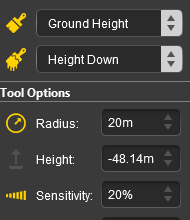 |
Set Height  |
Grade 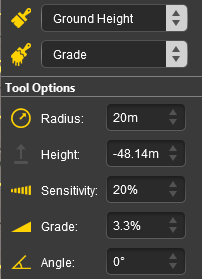 |
|
|||||||||||||||||||||||||||||||||
|
Ground Texture
|
When the Ground Texture Target is selected, the second drop down box will be disabled - there are no brush texture tool choices.
The available brush tool options are shown in the Tool Options Palette with a Gold coloured icon next to their names. Those options that have their icon greyed out will be ignored, but they can still be edited.
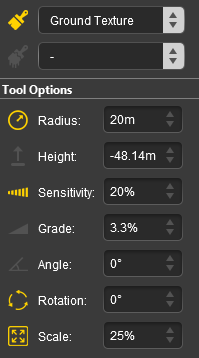 |
|
||||||||||||||||||||||||||||
|
Scrapbook Data
|
|
The Scrapbook Brush
When the Scrapbook Data Target is selected, the second drop down box will give a choice of two Scrapbook Data tools.
| The choices are:- | |
|
|
|
| The available brush tool options are shown in the Tool Options Palette with a Gold coloured icon next to their names. Those options that have their icon greyed out will be ignored, but they can still be edited. | |||||||||||||||||||||||||||||||
Scrapbook Brush 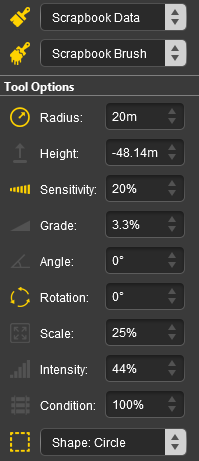 |
Scrapbook Clone  |
|
|||||||||||||||||||||||||||||
|
The Scrapbook Palette  |
|
|||||||||||||||||||||||||||||||||||||||||||
Edit Effect Layers...
When this Target is selected, the Edit Effect Layers options will appear. This is the same as selecting Edit Effect Layers ... from the Trainz Edit Menu.
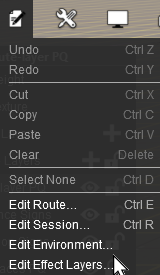 |
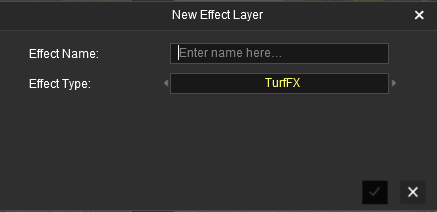 |
 |
 |
More information on creating and editing Effect Layers can be found on the Trainz Wiki at:- |
The Placement Tool
The Placement Tool is used to add objects to the route.
The first step is to identify and select the particular object that you want to add to the route. Placing a Scenery Mesh ObjectIndividual "non-spline" scenery objects that are not attached to track are often referred to in Trainz terminology as Scenery Mesh Objects.
Placing a Scenery or Track SplineTo start the process of laying a track or spline, follow the steps listed above for placing a Scenery Mesh Object.
Placement Tool Options
Deleting Placed Objects
The Eyedropper Tool
|
|||||||||||||||||||||||||||||||||||||||||||||||||||||||||||||||||||||||||||||||||||||||||||||||||||||||||||||||||||||||||||||||||||||||||||||||||||||||||||||||||||||||||||||||||||||||||||||||||||||||||||||||||||||||||||||||||||||||||||||||||||||||||||||||||||||||||||||||||||||||||||||||||||||||||||||||||||||||||||||||||||||||||||||||||||||||||||||||||||||||||||||||||||||||||||||||||||||||||||||||||||||||||||||||||||||||||||||||||||||||||||||||||||||||||||||||||||||||||||||||||||||||||||||||||||||||||||||||||||||||||||||||||||||||||||||||||||||||||||||||||||||||||||||||||||||||||||||||||||||||||||||||||||||||||||||||||||||||||||||||||||||||||||||||||||||||||||||||||||||||||||||||||||||||||||||||||||||||||||||||||||||||||||||||||||||||||||||||||||||



